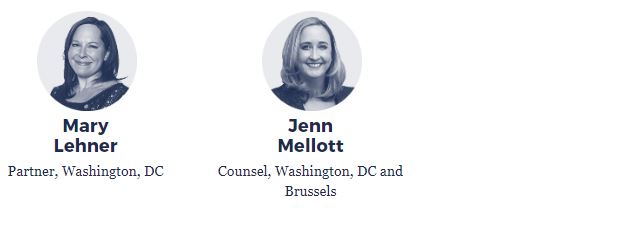Horizon 2020
The shifting antitrust landscape
Themes in tech, merger control, consortium bids and innovation

The digitalized economy
Last year saw broad debate in the US and worldwide as to whether there should be greater antitrust enforcement targeting the business models of digital platforms, and especially their use of data and algorithms–practices that have made many tech companies so successful. There has also been an increasingly active discussion around whether existing antitrust laws need reform to give the Department of Justice (DOJ) and Federal Trade Commission (FTC) the requisite tools to deal with issues raised by digital innovation.
In 2019 the FTC created a permanent Technology Enforcement Division, and is currently preparing digital guidelines relating to platforms in conjunction with the DOJ. Separately, state attorneys general have individually and collectively launched investigations into digital platforms.
In 2020, companies should expect heightened antitrust scrutiny of mergers where one or more parties has access to potentially valuable data, as well as those involving acquisitions of start-ups (sometimes called killer acquisitions). Likewise the business practices of digital platforms will be in the spotlight, including how they gather data or whether the data they hold could confer a competitive advantage or be considered an essential facility.
The DOJ and FTC are closely scrutinizing the digital economy, and the FTC has created a special technology unit to investigate and assess competition in digital markets. Companies should expect a closer examination of transactions conducted in the digital space.
New vertical merger guidelines on the horizon
In early 2020 the DOJ and FTC issued draft vertical merger guidelines for public comment. In the related press release, they noted that vertical merger enforcement has evolved dramatically since the current non-horizontal merger guidelines were issued in 1984. The new guidance is intended to reflect the agencies’ experience over the past 35 years, and more accurately outline their current enforcement approach.
The vertical merger guidelines will set out the DOJ and FTC’s approach to assessing transactions between companies that occupy different levels in a supply chain, such as a manufacturer and a distributor, or a distributor and a customer. Historically, the agencies have taken the view that such combinations are less likely to harm competition than horizontal mergers, consistent with the view of academics and economists that vertical mergers raise few competition risks and often have greater potential for efficiencies than those involving direct rivals. The agencies typically have required remedies only in cases where a monopolist or near-monopolist at one level of the supply chain would have the ability and incentive to foreclose downstream rivals’ access to a critical input, or where a firm acquires the only (or a key) upstream supplier for a critical input. Moreover, the FTC and DOJ have also been more willing in vertical cases to accept behavioral remedies, such as non-discrimination commitments or information firewalls. By contrast, in horizontal mergers the agencies have a strong preference for structural divestitures.
Under the Trump administration, the DOJ and FTC have shown heightened interest in vertical merger enforcement, best exemplified by the DOJ’s effort in 2017-18 to block AT&T’s merger with Time Warner. The case was the first effort by either agency to litigate a vertical merger challenge since 1977, when the DOJ sought to force Hammerhill, a paper manufacturer, to sell two paper distributors it had acquired in the 1960s. The DOJ lost that case, and suffered a similar fate in AT&T/Time Warner when the DC District Court rejected its claims and allowed the merger to proceed. The district court’s decision was affirmed following the DOJ’s unusual decision to appeal.
Following the DOJ’s defeat in AT&T/Time Warner, some commentators declared the case to be an outlier. However commentary from the DOJ and FTC since the decision suggests vertical mergers will continue to be an enforcement priority.
Following the DOJ’s defeat, some commentators declared AT&T/Time Warner to be an outlier, inconsistent with historic US enforcement priorities and antitrust scholarship. However, commentary from the DOJ and FTC since the decision, culminating with the draft vertical merger guidelines, suggests that vertical mergers will continue to be an enforcement priority in the future.
Working with financial investors: consortium bidding and interlocking directorates
We have seen a sharp uptick in the volume of consortia deals in the past 10 years. Such transactions can be a means to pool resources to go after an asset that is otherwise too big to acquire alone. They can also involve financial investors engaging strategic partners with a view to combining assets to realize synergies, bring different expertise to the group or address capability requirements in remedies processes. Private equity investors are increasingly employing buy-andbuild strategies or doing bolt-on acquisitions, both via joint investments and sequential deals.
Pooling resources can have material benefits but can also create risk. Acquiring targets as part of a consortium increases the likelihood of substantive competitive overlaps between the target and other portfolio company interests held by the investors. This is especially the case if the consortium includes strategic players and/or financial investors that have existing portfolio companies that are active in the same sector, even if they only hold minority stakes. It is crucial to identify potential competitive overlaps early in any deal process to be able to properly assess the level of antitrust risk and an appropriate strategic response, as well as allocating it among the parties.
More consortium members generally leads to a greater number of merger control and/or foreign investment control filings, with many jurisdictions triggering based on the turnover and/or assets of acquiring entities who will exercise control, even if the target has no turnover. Even minority stakes not amounting to control (with shareholdings as low as 10 percent) can give rise to filing requirements in some jurisdictions.
Companies should also expect enforcement to address any potential lessening of competition arising from so-called “common shareholdings” across the same industry. US agencies are this year expected to focus on cross-directorships, bringing enforcement actions where representatives of the same private equity firm sit on the boards of competing companies. Investors should ensure that where they have investments across an industry, they have appropriate confidentiality procedures in place.
This year, US agencies are expected to focus on situations where representatives of the same private equity firm sit on the boards of competing companies. Investors should ensure they have appropriate confidentiality procedures in place.
Mitigating regulatory risk from joint industry innovations
Bringing innovative products and services to market in Industry 4.0 and the sustainability space requires closer collaboration between companies than ever before – whether they are actual or potential competitors, suppliers or distributors. These ties raise innovative antitrust concerns compared to the theories of harm that the FTC and DOJ have investigated in more traditional sectors in the past.
For example, the DOJ has opened an investigation into whether automobile manufacturers violated antitrust law by agreeing to meet California’s emissions regulations, and DOJ Assistant Attorney General Makan Delrahim has emphasized that collusion among implementers of technological standards can push down patent licensing rates, thereby diminishing incentives to innovate.
Investigations such as these carry a serious risk of chilling dynamism in rapidly advancing technological spheres, as there is often no legal precedent or regulatory guidance to provide comfort that a collaborative effort can be structured in a way that is compliant with competition law. This is particularly true if competition regulators look to challenge R&D efforts as collusive under a theory that an even higher level of innovation could have been achieved than resulted from the collaboration.
Antitrust in an era of political fragmentation
The past year has already signaled a shift away from globalization in international politics. The US's volatile trade relationships with China and the EU – and the paralysis of the WTO – have undermined world trade, while a renewed focus on the impact of international conglomerates on local markets has challenged the orthodoxy of the global perspective of recent years.
Shifting political dynamics have also contributed to questions about whether competition authorities should focus on consumer fairness and industrial policy concerns in their investigations and decision-making. Assistant Attorney General Makan Delrahim has stood behind the consumer welfare standard as the lodestar of antitrust enforcement, while Federal Trade Commissioner Rohit Chopra has tied the US’s future economy and democracy to its ability to restore free and unfettered competition.
At the same time, as the US presidential campaign switches into high gear, we can expect candidates from both sides of the divide to continue their focus on consumer welfare. Companies should prepare themselves for increased scrutiny (both in a merger control context and via wideranging sector inquiries) to feed into policy updates or enforcement action. As national approaches diverge, international coordination will become even more critical to maximize companies’ chances of success.
In election year, expect continued scrutiny of high-tech industries and an intense focus on pharmaceutical pricing and other healthcare costs.
Your key contacts
-

Mary Lehner 合伙人
Washington, DC
-

Jenn Mellott Office Managing Partner, Washington DC
Washington, DC, Brussels

